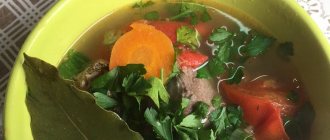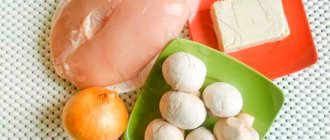From Japan around the world
The Japanese Momofuku Ando is considered the progenitor of modern instant noodles. In 1958, he founded and launched the world's first chicken-flavored ramen into the Japanese market. Since then, noodles with boiling water began their victorious march around the world.
You will be interested in: Egorievsky pate: factory products, pate composition, taste, calorie content, compliance with GOST requirements and customer reviews
A turning point in the company's history came in 1971, when marketers placed a briquette of noodles and spices in a sealed plastic plate with a fork, thereby eliminating the need for consumers to use utensils.
You may be interested in: “Zlato” oil: characteristics of taste and beneficial properties
Over time, dried vegetables and soy meat were added to the cup. And after 10 years, in addition to noodles, instant potatoes and all kinds of soups appeared.
Menu
Share on social networks:
TECHNICAL AND TECHNOLOGICAL CARD No. Ramen soup with chicken fillet
- APPLICATION AREA
This technical and technological map was developed in accordance with GOST 31987-2012 and applies to the Ramen Soup with chicken dish produced by a public catering facility.
- REQUIREMENTS FOR RAW MATERIALS
Food raw materials, food products and semi-finished products used for preparing dishes must comply with the requirements of current regulatory documents, have accompanying documents confirming their safety and quality (certificate of conformity, sanitary-epidemiological report, safety and quality certificate, etc.)
| 3. RECIPE | |||||
| Name of raw materials and products | Unit | Raw material consumption and | |||
| products for | |||||
| for 1 time | |||||
| Gross | Net | ||||
| Chicken fillet s/r “ | G | 30,000 | 30,000 | ||
| Peeled onion s/r” | G | 30,000 | 30,000 | ||
| Refined vegetable oil | ml | 15,450 | 15,000 | ||
| Sriracha sauce | G | 2,020 | 2,000 | ||
| Ramen p/f | G | 50,000 | 50,000 | ||
| Kikkoman soy sauce | ml | 15,150 | 15,000 | ||
| Extra table salt | G | 2,020 | 2,000 | ||
| Champignons s/r” | G | 20,000 | 20,000 | ||
| Chicken table egg 1 cat | PC | 1,000 | 1,000 | ||
| Peeled carrots s/r” | G | 15,000 | 15,000 | ||
| Green onion p/f” | G | 1,000 | 1,000 | ||
| Spices s/r | since then | 1,000 | 1,000 | ||
| Yield (in grams): | 300 | ||||
- TECHNOLOGICAL PROCESS
Chicken fillet and onion are cut into strips and fried.
Add Shirachi and soy sauce to boiling water, add champignons, cut into slices, and carrots, cut into strips, and bring to a boil.
Add chicken and onions to the broth, salt and cook until tender. Place boiled egg noodles on a plate, pour in the soup and place an egg cut in half on top.
Decorate the soup with finely chopped green onions.
- REQUIREMENTS FOR DESIGN, SALE AND STORAGE
Serving: The dish is prepared according to the consumer’s order and used according to the recipe for the main dish. Shelf life and sales according to SanPin 2.3.2.1324-03, SanPin 2.3.6.1079-01 Note: the technological map was compiled on the basis of a development report.
- QUALITY AND SAFETY INDICATORS
6.1 Organoleptic quality indicators:
Appearance – Characteristic of this dish.
Color – Characteristic of the products included in the product.
Taste and smell – characteristic of the products included in the product, without any foreign tastes or odors.
6.2 Microbiological and physico-chemical indicators:
In terms of microbiological and physicochemical indicators, this dish meets the requirements of the technical regulations of the Customs Union “On the safety of food products” (TR CU 021/2011)
- FOOD AND ENERGY VALUE
Ramen dishes with chicken” for 1 time yield 300
| Squirrels, | Fats, | Carbohydrates, | Calorie content |
| G | G | G | kcal |
| 16,943 | 20,828 | 23,775 | 350,323 |
Technological engineer:
Share on social networks:
Entering the Russian market
At a time when Japanese noodles were conquering first the Asian and then the world market by leaps and bounds, there was a void in the Russian segment of instant food products. Until the 90s, people had not heard or known about such food.
Everything changed in 1995, when a Korean company entered the Russian market with its product. The first appearance of noodles in Russia turned out to be the worst marketing ploy in the entire history of the company - it was called... “Dosirak”.
Later it was renamed “Dosilak”, and only after that the modern name “Doshirak” was approved, which became a common name for all brands of noodles.
Noodles for every taste
12 types of different flavors are produced on the Russian market: “Doshirak” with chicken, spicy chicken, kimchi, veal, mushrooms, pork, beef, bacon, cheese, tomatoes, seafood, and a special product for Russia - sauerkraut.
You will be interested: Does beets weaken or strengthen? The effect of beets on intestinal function
Overseas you can find other incredible flavors, such as seaweed, crab meat, teriyaki sauce, mirin sauce and many others.
Competitors in the noodle market
When “Doshirak” with chicken and other glutamate additives was just starting to conquer the market, he was a pioneer, but, as they say, a holy place is never empty. Competition appeared in the instant noodle market almost overnight.
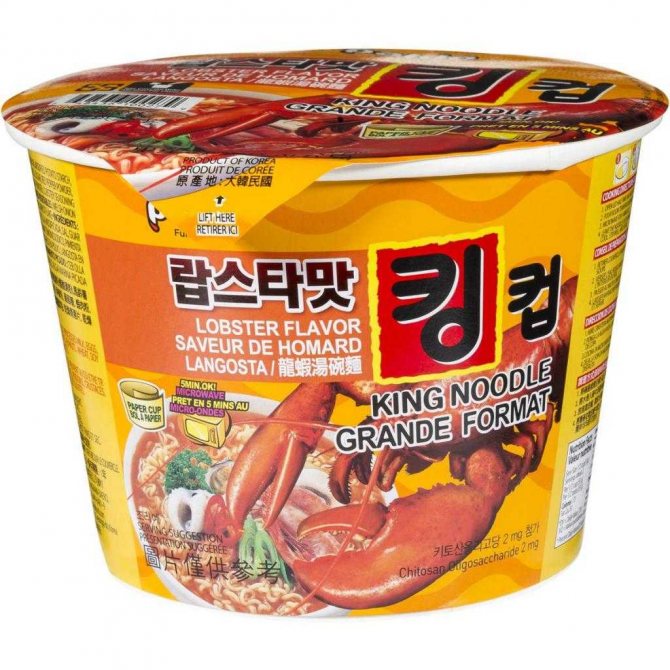
The Chinese Kanshifu, the Russian-Ukrainian Rollton, Big Bon, and Anakom tried to compete with Doshirak. Each of these brands tried to find its segment in the Russian market, but none of them became the number one brand. And Doshirak’s ratings are still impressive.
How to cook Japanese ramen noodles?
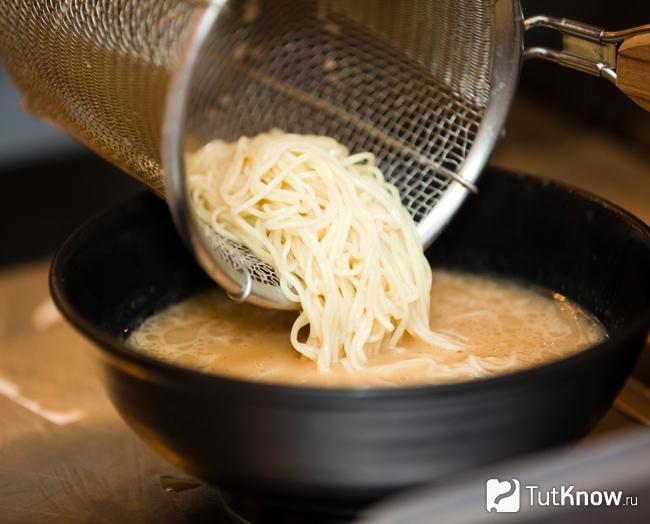
Of course, you've probably already eaten ramen at least once in your life, although you didn't know that you were eating it, because you bought something called “instant noodles.” Indeed, our store shelves are replete with this category of product; you can buy ramen for very little money and still get a complete meal.
However, the composition of the briquettes for brewing often leaves much to be desired, and therefore, if you value your health and real taste, the best solution is to make ramen at home yourself. The recipe is actually quite simple.
Recipe for making ramen:
- Pour wheat flour (3/4 cup) into a bowl. Ideally, you need to mix 2 types of flour - with high and low gluten content, and the first should take 2 parts, the second - 1 part. Unfortunately, it is quite difficult to find such flour in Russia, although it is very popular in Asia. However, nothing bad will happen if you take classic wheat flour.
- Add salt (3/4 tsp) to the flour and mix well.
- Make a hole in the dry mass and break an egg (1 piece) into it, pour in water (1 tablespoon), stirring gently and combine all the ingredients well.
- Remove the dough from the bowl, knead it well - the texture should be stiffer than classic bread dough and moderately sticky. To check the correct “stickiness”, take the dough in your hands and release it: if after about a couple of seconds it falls, then you have achieved the ideal proportions; if the dough is too sticky, add a little flour; if, on the contrary, it is very dry, add water.
- Let the dough rest for a while, then place it in a damp cotton cloth. Keep in it for half an hour to 2 hours.
- Now take the dough and roll it out as thick as possible - if it sticks, use flour.
- Let the layer rest for a bit - 5-7 minutes, then take a sharp knife and start cutting strips. Real ramen is very thin, so try to cut it as thin as possible. Don't be afraid to use a lot of flour to remove the stickiness, all of it will wash off during cooking.
- Place the finished noodles in a bowl.
Now you can boil ramen and get the freshest and most delicious dish. To cook ramen, bring water to a boil and throw in the noodles; if you did everything correctly, the side dish will cook in 3-5 minutes.
Noodles are not as harmful as they are made out to be
The most popular flavor in the entire line remains Doshirak noodles with chicken. Both adults and children love it; all Russian long-distance trains, rotational shifts and student rental apartments smell of it. What about adults! All children of the 90s remember how they gnawed dry noodles until their mother saw.
It is the latter - parents and adherents of proper nutrition - who have taken up arms against all kinds of five-minute meals. Let's look at what is included in Doshirak with chicken, and is this noodle so scary?
The standard kit includes a dry briquette, a bag of oil, a package of dried herbs and a small pack of spices. The noodles are regular egg or wheat noodles that are part of the popular Japanese ramen. Without spices and salt, it can hardly be distinguished from the one that caring housewives put in the soup.
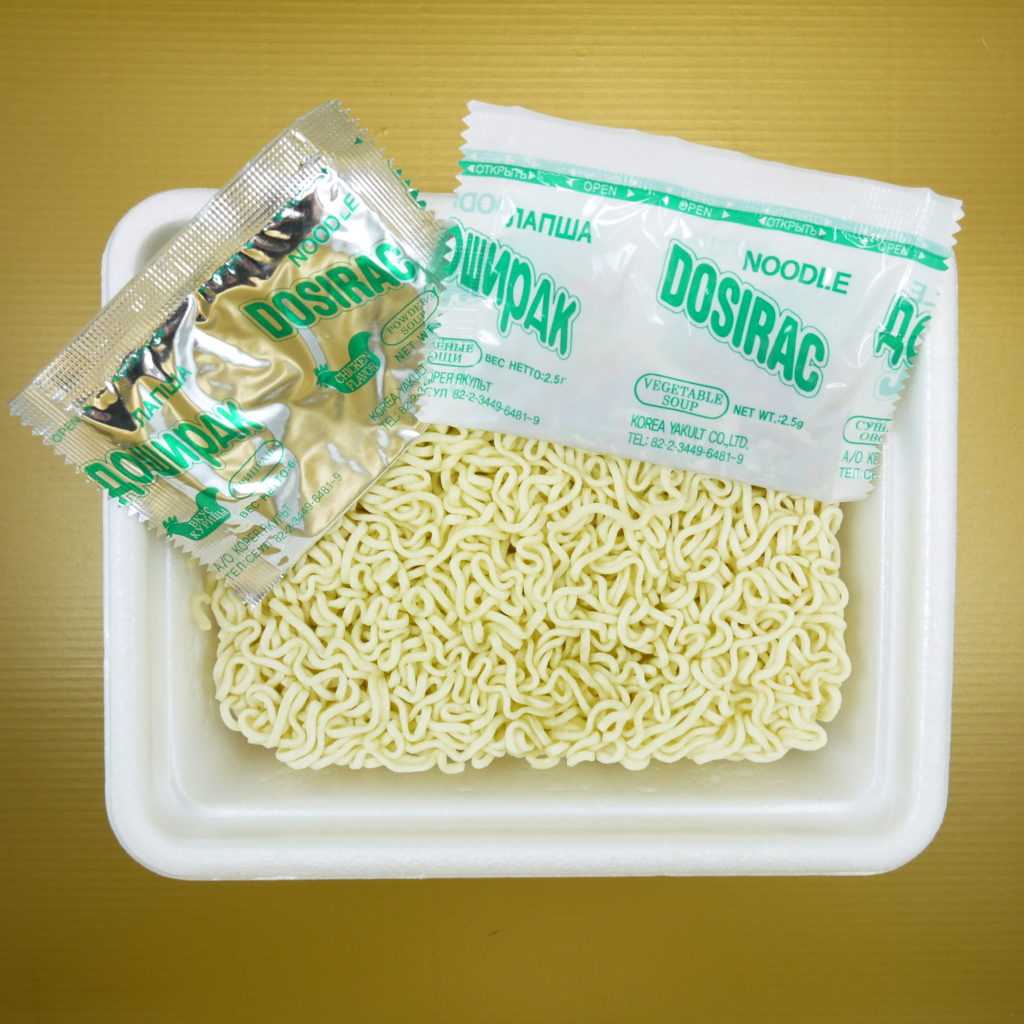
Soy meat, although it has a mild taste, is in itself completely safe for both adults and children. Dried herbs and oil also do not pose any danger.
The secret of Korean noodles is in the third packet of unknown spices. This includes monosodium glutamate - known among Russians as a flavor enhancer, and for Asians - a common seasoning that takes pride of place next to salt and pepper. And a mixture of various spices in different proportions.
If you consider that there is no more glutamate in noodles than in a regular hamburger, and the treasured packet that gives the noodles its piquancy and taste does not need to be poured out at all, then Doshirak with chicken is no more harmful than any pasta on the supermarket shelves.
Health benefits of ramen noodles

Japanese ramen is rarely or never served simply as a regular side dish: at least in Asia, you're sure to get it in a hearty broth with meat or seafood, as well as plenty of vegetables. That is why, first of all, the benefit of the product lies in the fact that it is part of a nutritious dish, the vitamin and mineral value of which is mainly made up of additional ingredients.
However, if we talk directly about noodles, it is worth mentioning the following positive effects:
- Saturating the body with energy . Despite the fact that the carbohydrate part of the product is represented by simple carbohydrates, which are not capable of providing energy for a long time, due to the presence of eggs in the composition, noodles also become a protein product, but protein is distinguished by its ability to saturate for a long time. In addition, the composition includes B vitamins - these are the main vitamins for metabolic processes, that is, they contribute to a more efficient conversion of food into energy.
- Improving the functioning of the nervous system . In addition, B vitamins have a beneficial effect on the nervous system, and therefore, by eating the product regularly, you can count on some improvement in its functioning. Of course, you shouldn’t expect significant changes, but ramen will definitely lift your spirits.
- Support of overall vitamin and mineral balance . Since the product also contains other vitamins and minerals, albeit in small quantities, it helps to make an important contribution to the overall vitamin and mineral balance, positively influencing not only various internal organs and tissues, but also the bone skeleton, teeth, hair, skin .
Of course, the dish cannot be called either nutrient dense or dietary, and, nevertheless, occasionally it can be included in the diet of everyone purely for pleasure, although, of course, it is desirable that the rest of the menu be made up of foods rich in vitamins and minerals . The best time to eat ramen is at lunchtime.
Three steps from noodles to excess weight
You may be interested in: Cutting beef: features, parts of the carcass, types of meat
If you consider how much fast and junk food the average person consumes, remember that chicken contains antibiotics, the rest of the meat contains hormones, and potatoes are completely genetically modified, then we can come to the conclusion that Doshirak noodles with chicken are not the most deadly delicacy , in a plastic box waiting for you to pour boiling water over it.
There is nothing dangerous to health in eating such food once or twice a month, in emergency situations such as a train or a hike. But will your waistline thank you?
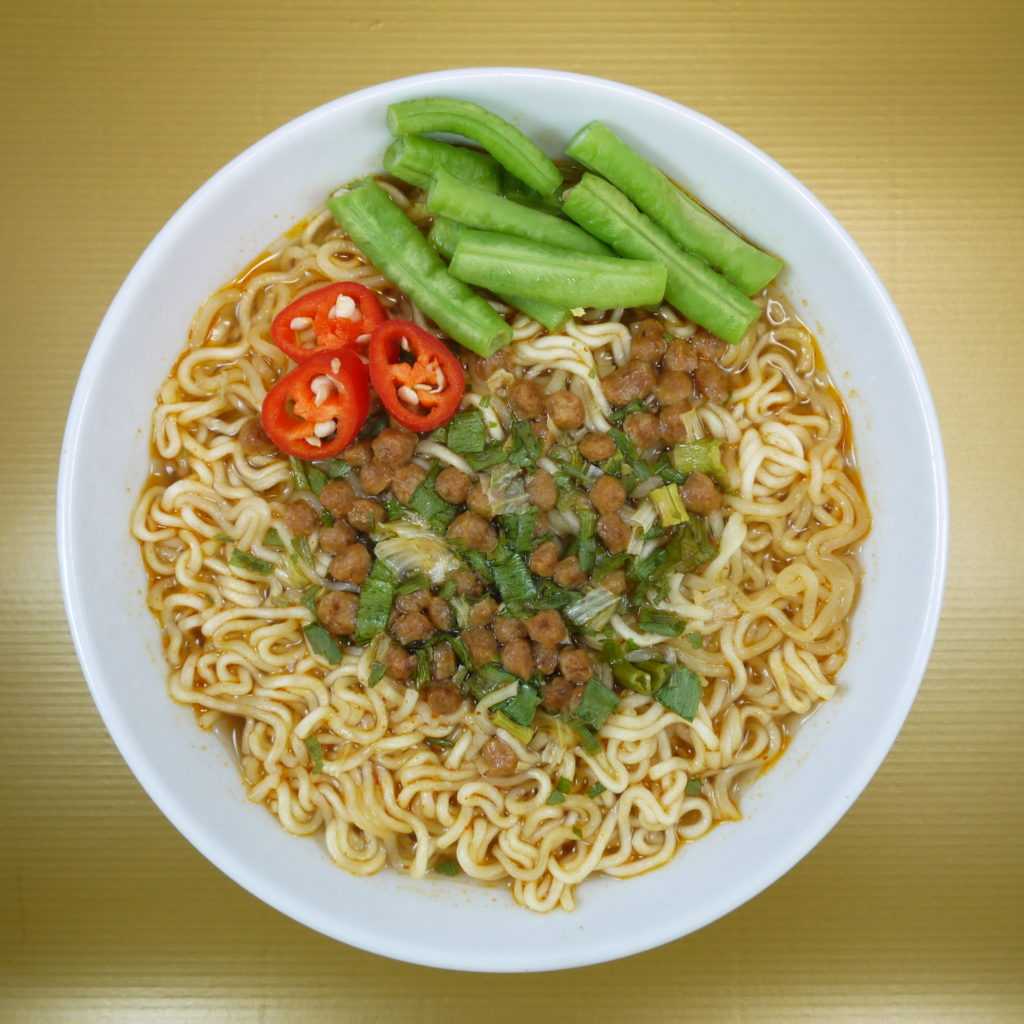
In its finished form, the calorie content of doshirak with chicken is 455 kilocalories. Four servings per day will cover the energy needs of an adult man. One serving makes for a satisfying but unbalanced lunch—just 9 grams of protein for 62 grams of simple carbohydrates that will have you looking for something to snack within an hour of eating.
Noodles with beef contain 440 kilocalories, which is only 15 less than Doshirak with chicken. How many calories are in empty noodles? A little less - 412. That is, this product, in any case, is not at all suitable for those losing weight. In addition, the excess salt contained in the seasoning will retain water in the body, and it will also give an increase on the scales.
From snack to full meal
Since the mid-90s, the appearance of noodle packaging has not changed much, but the range of flavors and portions has expanded significantly. The weight of Doshirak noodles with chicken and other flavors ranges from 70 to 140 grams.
- “Kvisti” is “Doshirak” in a bag, the smallest of all possible portions of noodles: only 70 grams. In addition, this variation is considered the most bland of the entire line.
- “Doshirak Plus” is a standard instant noodle, complete with a sachet of mayonnaise. Weight - 105 grams.
- “Doshirak big lunch” - a portion of noodles in a bucket, a maxi-portion for those who are especially hungry. Weight -140 grams.
- “Chan Ramen” is the elite among “Doshirak”. Regular ramen that requires cooking, complete with a fairly tasty sauce.
- “Doshirak. Mashed potatoes" is a new product in the company’s line.
But dry weight gives little idea of the finished portion of the dish. How many grams are in ready-made Doshirak with chicken or beef? If we take into account that it is recommended to add a glass of boiling water to the pack, then the weight of the finished portion increases by about 200 grams - from 270 to 350, depending on the chosen noodles.
Simple homemade recipe

Traditionally, ramen noodles consist of four ingredients - water, salt, wheat flour and a spoonful of alkaline water (which gives it its characteristic yellow tint). However, at home you can use rice, buckwheat or egg noodles.
The broth is cooked separately, and the noodles are cooked separately, and almost at the end. When serving ramen, a portion of noodles is poured with hot broth, and additional ingredients are added on top - vegetables, spices, tofu, and so on. The process of preparing a simple ramen can take 20 minutes, and a complex gourmet version can take hours.
How to quickly cook ramen?
The fastest way to prepare vegetarian ramen is with a broth made from soy sauce or misu paste - cooking a full-fledged broth from beef or pork will take about an hour. You will need vegetables (cabbage, leeks, parsley), a slice of lemon, ginger, red hot pepper (to taste), mushrooms and tofu.
- Prepare the broth - for one serving of ramen you need about 250 ml of water (or ready-made vegetable broth). Finely chop the available vegetables, add to cold water, bring to a boil, then reduce heat. Add finely chopped ginger, red pepper, soy sauce and a spoon of brown sugar. Cook for 5 minutes.
- Fry the filling - fry finely chopped mushrooms or other ingredients in a separate pan. Not only tofu is suitable, but also chicken, beef or pork. It is best to fry it in sesame oil - it is this that gives the ramen its traditional islandy-piquant taste.
- Boil the eggs – an optional homemade ramen recipe can include eggs. It is recommended to cook them “in a bag”, for which place the eggs in a saucepan with cold water, bring to a boil and cook for exactly 4 minutes. Cut in half before serving.
- Boil the noodles - let us remind you that to prepare ramen you must use either special wheat noodles, or egg, rice or buckwheat noodles. It is better to check the cooking time on the packaging, but usually it is about 3-5 minutes.
- Place the ramen in the bowl - start with the noodles, then add the broth, then top with the fried toppings, eggs, and so on. The dish is served hot.
Ramen with pork
And yet, if you move away from traditional prejudices and have a little time left, you can easily prepare a tasty and satisfying dish from instant noodles - Japanese ramen with pork.
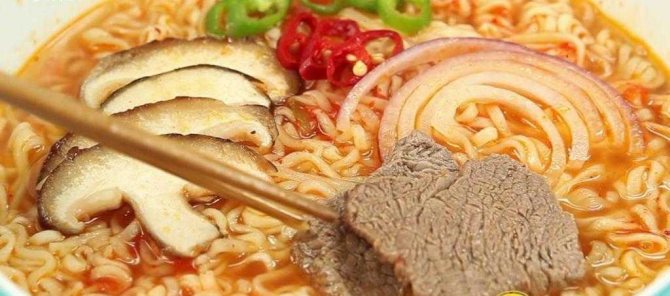
To prepare you will need:
- pork tenderloin - 500 grams;
- two packages of dry Doshirak noodles, 140 grams each, without spices;
- 10 grams of salt;
- 10 grams of sugar;
- 100 grams of soy sauce;
- 15 grams of rendered pork fat;
- 10 grams of ginger;
- 1 gram of cinnamon;
- greenery.
Preparation:
- Rinse the pork thoroughly and cut into small pieces.
- Place in a saucepan and cook for 30 minutes.
- Remove the meat and strain the broth.
- Place ginger and cinnamon on the bottom of a clean pan, place pork on top, pour in half the broth, add salt, sugar and soy sauce. Cook for 3 hours.
- Boil a liter of water in a separate saucepan, add Doshirak noodles without spices for three minutes, and drain in a colander.
- Pour 500 milliliters of water into a clean saucepan, bring to a boil, add the remaining broth and pork fat.
- Divide the noodles into bowls. Pour the resulting broth, add pork, garnish with herbs.
Homemade Korean chicken ramen soup
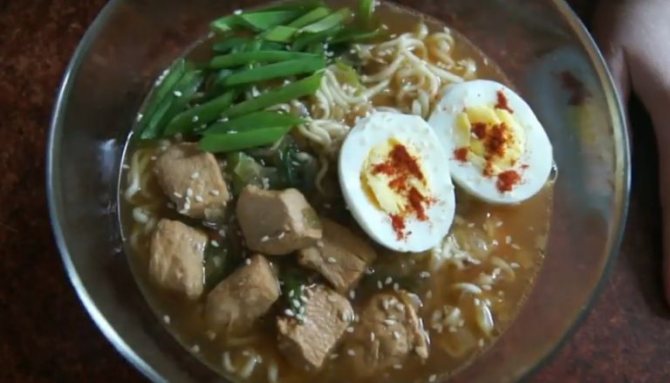
Ingredients
- 2 packs of instant noodles;
- 1 chicken fillet;
- 1.5-2 liters of hot water;
- 4 boiled eggs.
- 1 small onion;
- 1/3 packet of teriyaki sauce;
- 1/2 tsp. dried ginger;
- 1 tsp dried garlic;
- 5-6 pcs. green onion feathers;
- handful of sesame seeds
Preparation
- 1. Peel and chop the onion, cut the chicken into medium-sized cubes. Boil the eggs hard.
- 2. Heat a little vegetable oil in a frying pan, add the onion first, fry until soft. Then add the fillet pieces. Fry them until half cooked, stirring occasionally. Add garlic and ginger.
- 3. To give the chicken a golden hue and a piquant taste, add sauces. Pour in the soy water first, stir, then the teriyaki and stir again. Cook for a few minutes.
- 4. Pour in water, reduce heat to medium and simmer covered for 10 minutes. Chop the green onions and add to the broth, stir.
- If desired, you can add dried vegetables left over from the instant noodles to the broth.
- 5. Boil 1 liter of water in a saucepan and lower the noodles. Cook for 4 minutes, then immediately divide into serving bowls. Pour broth over pasta and add chicken pieces.
- Cut each egg into halves and place on plates, sprinkle with paprika and sesame seeds on top.
Ramen with chicken and Doshirak
Photos of such ramen always look very appetizing: green onions, bright eggs, crispy chicken and curly noodles. Still, poultry meat is not so popular in Asia due to its low fat percentage. But for Europeans this is more of a plus than a minus.

To prepare, take:
The recipe for chicken ramen differs little from the fattier pork one:
Simple ramen with spicy chicken

Ingredients for Easy Spicy Chicken Ramen:
- Chicken fillet – 150 g
- Lemon grass - 1 pc.
- Salt - 1 pinch.
- Honey - 1 tbsp. l.
- Red hot pepper - 1 pinch.
- Broth (or water) - 1200 ml
- Soy sauce - 6 tbsp. l.
- Green onion (pair of arrows) - 1 bunch.
- Vegetable oil (for frying)
- Noodles – 150 g
Easy Spicy Chicken Ramen Recipe:
- Finely grate the lemongrass and sprinkle it over the chicken fillet. Add salt, honey and pepper to the chicken as well. Set aside for a couple of minutes and let the noodles cook.
- Fry the chicken over high heat until cooked (depending on the size of the fillet pieces). Cut into thin slices.
- The noodles should also be ready at this time. Drain it in a colander.
- Pour the broth into serving bowls and add Kikkoman soy sauce to it (for example, 3 tablespoons in each - depends on the salinity of the broth). Place chicken slices on top and sprinkle with green onions.
Instant noodle salad
But, as they say, a man is not full with soup alone. Russians are crafty when it comes to invention, and from banal products like crackers or chips they prepare salads worthy of a festive table. The same thing happened with Korean-Chinese noodles. It is not known who first came up with the idea of throwing a packet of Doshirak into a salad bowl, but it turned out at least interesting. So if you are tired of the traditional Olivier, go for it!
To prepare you will need:
- Korean carrots - 300 grams.
- Boiled sausage - 300 grams.
- Cheese - 200 grams.
- A pack of Doshirak or any other instant noodles without spices.
- Mayonnaise to taste.
Cut the sausage and cheese into cubes. Finely chop the noodles. Mix all ingredients, season with mayonnaise and let brew for 30 minutes.
Ramen with chicken: composition, calorie content and nutritional value per 100 g
| 1 chip | Fresh ginger (root) | 60 g |
| Sesame oil | ||
| 2 tsp. | Sesame | taste |
| Carrot | ||
| 1 PC. | Granulated sugar | 1 tsp. |
| Green onion | ||
| 4 banter | Garlic | 3 teeth |
| Nori | ||
| 1 PC. | Spinach | 100 g |
| Chicken drumstick | ||
| 3 pcs. | Chicken egg | 4 things. |
| Vermicelli | ||
| 375 g | Chicken fillet | 300 g |
| Bulb onions | ||
| 1 PC. | Soy sauce | 4 tbsp. l. |
| Cayenne pepper (chili) ground |
Prepare the broth: place chicken drumsticks in a saucepan, add coarsely chopped carrots and onions, add water (about 1.5 liters) and cook for about an hour. Strain the broth.
Add soy sauce, finely chopped ginger, garlic and chili to the broth. Bring to a boil, reduce heat and cook for another 5 minutes. Taste the broth and add either sugar or more soy sauce if necessary.
Prepare noodles according to package directions.
Cut the chicken fillet into pieces and fry in a frying pan with sesame oil.
Boil eggs in a bag. To do this, put them in a saucepan with cold water, put it on the fire, bring to a boil and cook for another 4 minutes.
Divide the noodles among four bowls and pour the broth over them. Place fried chicken pieces, two egg halves and a handful of spinach on each plate. Top with chopped green onions, finely chopped nori and sesame seeds.
Favorite noodles for children and adults
One of the first advertisements for this product contained the slogan “People love Doshirak.” Either the marketing was really good, or the idea was new and therefore attracted people, or the speed and convenience of preparation were well suited for long trips around our vast homeland, but noodles gained popularity almost instantly.
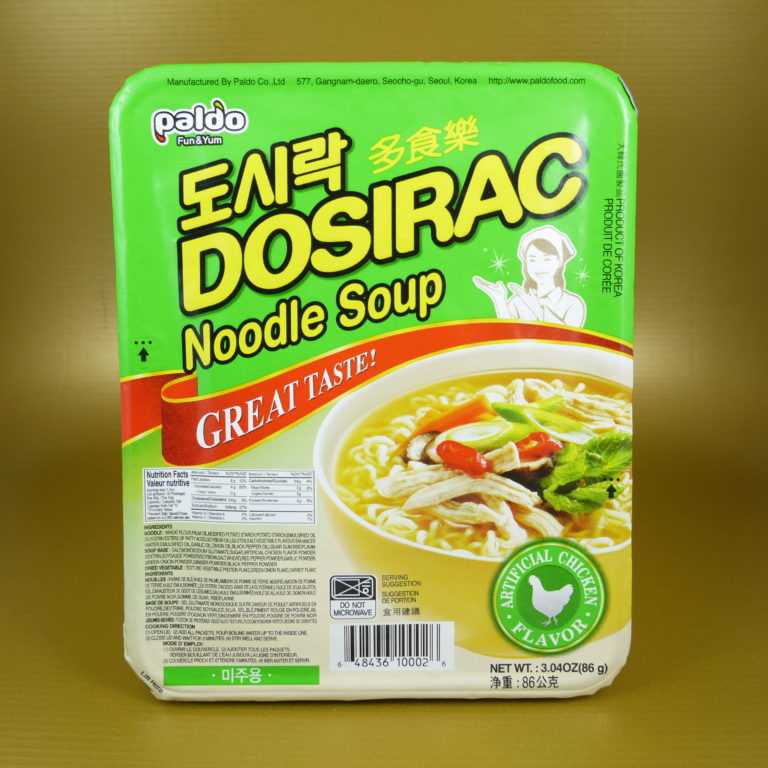
“Doshirak” with chicken, according to consumer reviews, is the best noodle in its segment. A convenient foam box will prevent you from burning your hands; the portion is sufficient for an adult. Very often people complain that food is too spicy or salty, but this problem is easily solved by reducing the amount of spices.





